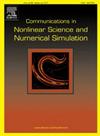Self-oscillation-driven locomotion in a liquid crystal elastomer-based robot under constant illumination
IF 3.4
2区 数学
Q1 MATHEMATICS, APPLIED
Communications in Nonlinear Science and Numerical Simulation
Pub Date : 2025-02-25
DOI:10.1016/j.cnsns.2025.108706
引用次数: 0
Abstract
A vibration-driven locomotion robot, excited by periodic time-varying excitations has recently been studied and developed, which requires a complex controller. To simplify the control scheme, this article constructs a self-oscillation-driven locomotion in a liquid crystal elastomers (LCE)-based robot under constant illumination. This system consists of a robot's body and a self-oscillating LCE strip-spring oscillator. Based on the evolution of photothermal temperature, the control equations for the self-oscillation-driven locomotion robot are derived. Through numerical calculations, two patterns are identified, namely, the static pattern and the self-locomotion pattern, and the mechanism of self-locomotion is revealed. In each cycle of self-oscillation, the photothermal-driven contraction and relaxation of the LCE strip are asymmetric, generating a net displacement and enabling the robot to achieve locomotion driven by the self-oscillating oscillator. In addition, the effects of various system parameters on the amplitude and frequency of self-oscillation, as well as the average velocity of self-locomotion, are numerically evaluated. The self-oscillation-driven locomotion robot features inherent asymmetry and autonomous control, operating without the need for an additional controller. This makes it well-suited for applications in medical care, adaptive robotics, and artificial intelligence.
求助全文
约1分钟内获得全文
求助全文
来源期刊

Communications in Nonlinear Science and Numerical Simulation
MATHEMATICS, APPLIED-MATHEMATICS, INTERDISCIPLINARY APPLICATIONS
CiteScore
6.80
自引率
7.70%
发文量
378
审稿时长
78 days
期刊介绍:
The journal publishes original research findings on experimental observation, mathematical modeling, theoretical analysis and numerical simulation, for more accurate description, better prediction or novel application, of nonlinear phenomena in science and engineering. It offers a venue for researchers to make rapid exchange of ideas and techniques in nonlinear science and complexity.
The submission of manuscripts with cross-disciplinary approaches in nonlinear science and complexity is particularly encouraged.
Topics of interest:
Nonlinear differential or delay equations, Lie group analysis and asymptotic methods, Discontinuous systems, Fractals, Fractional calculus and dynamics, Nonlinear effects in quantum mechanics, Nonlinear stochastic processes, Experimental nonlinear science, Time-series and signal analysis, Computational methods and simulations in nonlinear science and engineering, Control of dynamical systems, Synchronization, Lyapunov analysis, High-dimensional chaos and turbulence, Chaos in Hamiltonian systems, Integrable systems and solitons, Collective behavior in many-body systems, Biological physics and networks, Nonlinear mechanical systems, Complex systems and complexity.
No length limitation for contributions is set, but only concisely written manuscripts are published. Brief papers are published on the basis of Rapid Communications. Discussions of previously published papers are welcome.
 求助内容:
求助内容: 应助结果提醒方式:
应助结果提醒方式:


